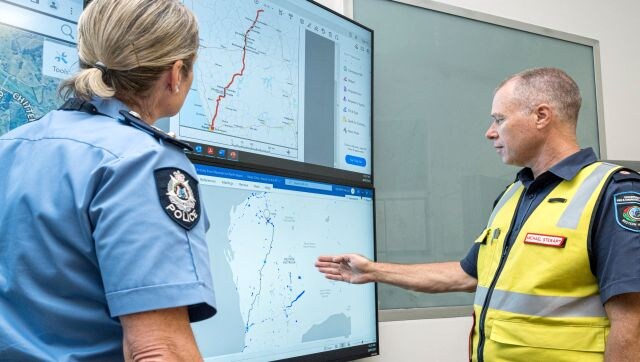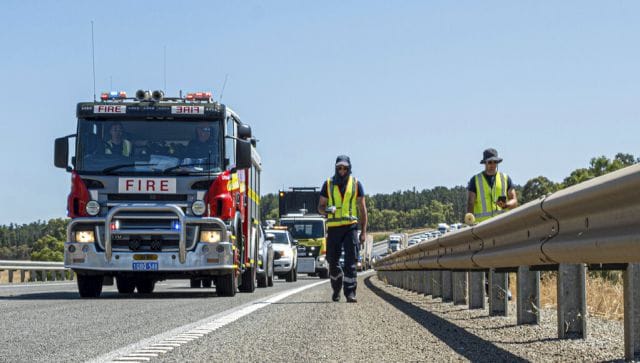A radioactive capsule smaller than human nail is lost in Australia. Here’s why it’s deadly and creating an alarm
A radioactive capsule smaller than human nail is lost in Australia. Here’s why it’s deadly and creating an alarm

It’s a tiny capsule about eight millimetres in length. It’s lost in Western Australia and it has triggered panic. But why? It contains a small amount of the radioactive isotope Caesium-137, which is lethal.
How was the capsule misplaced?
The capsule belongs to Australian mining giant Rio Tinto. It was lost between the town of Newman and the city of Perth, which is a distance of approximately 1,400 kilometres.
The solid, silver-coloured cylinder, which is smaller than a human fingernail, fell off a truck along the highway that passes through the Western Australian desert.
According to Rio Tinto, the widget was collected from a mine on 12 January by a transport conductor and was scheduled to arrive at a radiation storage facility in Perth on 16 January. It was only when the container was opened for inspection on 25 January that it was discovered that the capsule was missing.
The Western Australian government said when the package holding the device was inspected, it was found to have been “broken apart with one of the four mounting bolts missing and the source itself and all screws on the gauge also missing”, reports Bloomberg.
Why is the capsule so lethal?
The capsule is part of a gauge used to measure the density of iron ore feed.
Its radioactive material emits both gamma and beta rays and has a half-life of 30 years. Standing within a metre of the capsule is the equivalent of receiving 10 X-rays in an hour, health authorities have warned.
The widget contains a small quantity of Caesium-137, a radioactive isotope that can cause damage to anyone who touches it.

What is Caesium-137?
Caesium is a soft, flexible, silvery-white metal that becomes liquid near room temperature, but easily bonds with chlorides to create a crystalline powder. Caesium-137 is the most common radioactive form of caesium. It is produced by nuclear fission; it is also one of the byproducts of nuclear fission processes in nuclear reactors and nuclear weapons testing, according to the United States Environmental Protection Agency (EPA).
Caesium-137 can cause serious illness when touched, leading to burns and acute radiation sickness. External exposure can increase the risk of cancer because of the presence of high-energy gamma radiation. Prolonged exposure can even cause death.
Internal exposure to it through ingestion or inhalation allows the radioactive material to be distributed in the soft tissues, especially muscle tissue, which increases cancer risk, warns EPA.
Large amounts of Caesium-137 are not found in the environment in normal circumstances. However, mishandling of industrial sources, a nuclear detonation or a major nuclear accident can cause it to leak.
Have there been major incidents involving Caesium-137?
One of the biggest Caesium-137 contaminations happened during the Chernobyl nuclear power plant accident of 1986. During the explosion around 27 kg of the metal was expelled into the atmosphere. It was the predominant source of radiation in the fallout from the disaster. In 2002, sixteen years after the disaster, a 4000 sq km area still contained too much Caesium-137 to be inhabited or used for agricultural purposes, according to a 2012 research paper titled “Cesium-137: A Deadly Hazard”.

After the Fukushima nuclear disaster in Japan in 2011, triggered by an earthquake and tsunami, Caesium-137 was found in trees, soils, and mushrooms in the forest area contaminated around the Fukushima Daiichi Nuclear Power Plant.
Chernobyl and Fukushima are examples where the metal can contaminate water bodies, trees, and soil surfaces and can be ingested with food and water.
In India, in January 2019, a small container of Caesium-137 went missing from a truck ferrying machinery and tools from an ONGC exploration site in Andhra Pradesh. The missing box caused concern and panic with police and ONGC officials searching for it. It was found intact at a scrap shop.
The incident is similar to what is happening in Australia right now.
What’s the latest on the Rio Tinto capsule?
Rio Tinto and Western Australia are trying to find the widget. While the risk to the general community is low, exposure to the substance could cause radiation burns or radiation sickness, Emergency WA said on its website, reports Bloomberg.
Western Australia’s Department of Fire and Emergency Services (Dfes) has deployed new radiation detection equipment that could be fitted in vehicles to help find the capsule. Teams with metal detectors have also been pressed into action. However, there is fear that the tiny capsule might have been lodged in the tyre of another vehicle and could have travelled far away from the search area.
Officials in high-visibility yellow vests were seen walking along key stretches of the road, such as where the truck had stopped, but the capsule remains missing.

David Gill, a chief superintendent at Dfes, told the media on Saturday that emergency services crews were undertaking a “concerted, coordinated” search for the capsule. “There is the potential that we may not find this… That is possible,” he said.
Finding the capsule will not be easy, said Dale Bailey, professor of medical imaging at the University of Sydney and Royal North Shore Hospital. “Given the large distance involved it will be akin to finding a needle in a haystack,” Bailey said.
The desert where the capsule is lost is remote and one of the least populated places in the country. Only one in five of Western Australia’s population lives outside of Perth, the state’s capital, reports BBC. But officials are concerned that someone could pick up the capsule, not knowing what it is.
What is Rio Tinto saying?
Rio Tinto apologised Monday for losing the tiny but dangerously radioactive capsule.
“We recognise this is clearly very concerning and are sorry for the alarm it has caused in the Western Australian community,” said Rio Tinto Iron Ore chief executive Simon Trott in a statement sent to AFP. “We have launched our own investigation to understand how the capsule was lost in transit.”
This is not the first time the mining company is hitting headlines for the wrong reason. Its public image took a hit in an unrelated incident in 2020 when it blew up the 46,000-year-old Juukan Gorge rock shelters in Western Australia, sparking a scathing parliamentary inquiry and promised reforms.
With inputs from agencies
Read all the Latest News, Trending News, Cricket News, Bollywood News,
India News and Entertainment News here. Follow us on Facebook, Twitter and Instagram.
What's Your Reaction?

























































